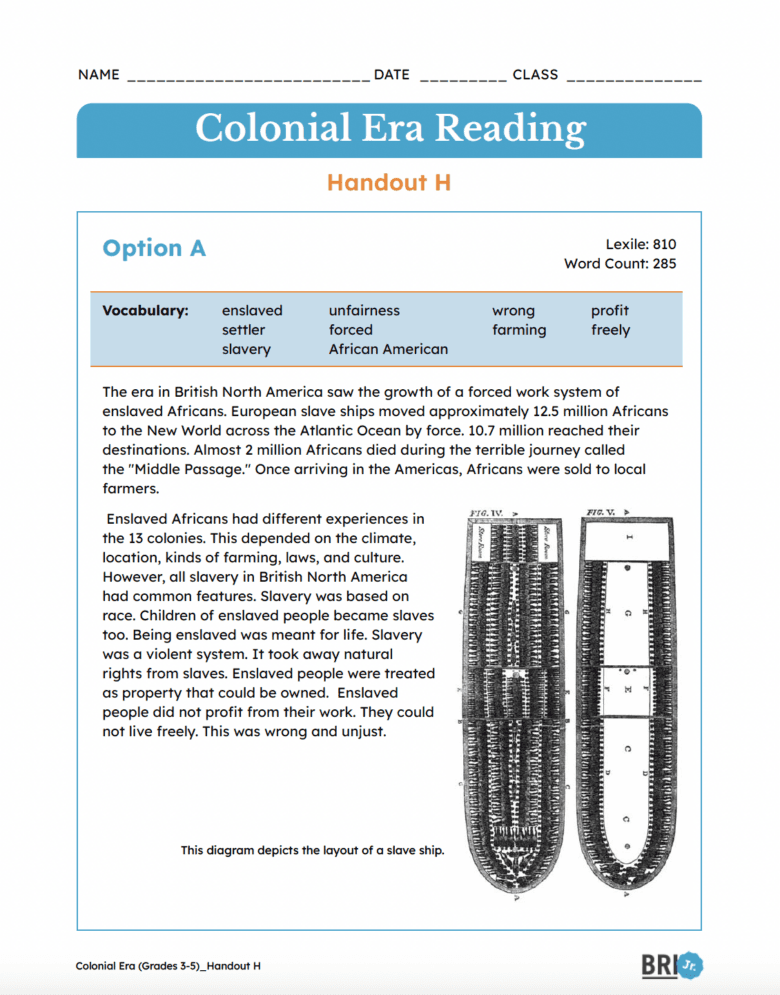Slavery in the Colonies Reading for Elementary Students
Primary sources documenting the slave trade in the colonial era.
Option A
Lexile: 810
Word Count: 285
Vocabulary: enslaved, unfairness, wrong, profit, settler, forced, farming, freely, slavery, African American
The Colonial era in British North America saw the growth of a forced work system of enslaved Africans. European slave ships moved approximately 12.5 million Africans to the New World across the Atlantic Ocean by force. 10.7 million reached their destinations. Almost 2 million Africans died during the terrible journey called the “Middle Passage.” Once arriving in the Americas, Africans were sold to local farmers.

This diagram depicts the layout of a slave ship.
(source: https://en.wikipedia.org/wiki/Middle_Passage#/media/File:Slave_ship_diagram.png)
Enslaved Africans had different experiences in the 13 colonies. This depended on the climate, location, kinds of farming, laws, and culture. However, all slavery in British North America had common features. Slavery was based on race. Children of enslaved people became slaves too. Being enslaved was meant for life. Slavery was a violent system. It took away natural rights from slaves. Enslaved people were treated as property that could be owned. Enslaved people did not profit from their work. They could not live freely. This was wrong and unjust.

Slaves developed their own culture as a way to bond together in their hardships and show defiance to their owners. This image depicts slaves on a plantation dancing and playing music.
(source: https://en.wikipedia.org/wiki/Slavery_in_the_United_States#/media/File:Slave_dance_to_banjo,_1780s.jpg)
Different climates and economies led to different farming systems and patterns of forced work. The North had smaller farms and fewer enslaved people. The South relied on large farms with many slaves, sometimes more than the white settlers. The North used more enslaved people in cities. The South used them to work on farms.

Tobacco Plant. Tobacco was one of the main cash crops on Southern farms that used enslaved workers.
(source: https://commons.wikimedia.org/wiki/File:Tobacco_Plant_by_J_W_Orr.jpg)
Even through the violence of forced work, enslaved people resisted in many courageous ways. They slowed down work and fought back by stealing food and running away. They created their own cultures and continued traditions. They expressed resistance through spiritual songs and community activities. The unfairness of slavery was common, denying Blacks their humanity and natural rights. Some white settlers spoke out against the horrors of forced work early on. But ending slavery took a long time.
Option B
Lexile: 780
Word Count: 323
Vocabulary: enslave, enslaved, unjust, wrong, courageous, settler, farming, freely, colonial, slavery
The Colonial era in British North America saw a system of slavery grow. During this time, Africans were forced across the Atlantic Ocean on European ships in what is known as the slave trade. These ships moved more than 12.5 million Africans to North America, and almost 2 million died during the “Middle Passage.” Once they arrived, these people were sold into slavery, and their lives were forever changed.

This diagram depicts the layout of a slave ship.
(source: https://en.wikipedia.org/wiki/Middle_Passage#/media/File:Slave_ship_diagram.png)
Enslaved Africans had different experiences in the 13 colonies. This depended on climate, location, farming, laws, and culture. Yet, all slavery in British North America shared common things. Slavery was based on race. Children of enslaved people became enslaved automatically. And slavery was meant for life. Slavery was a violent system. It took away enslaved people’s natural rights. It treated them as property by law. Enslaved people did not gain from their work. They could not live freely. It was a great wrong and unjust.

Slaves developed their own culture as a way to bond together in their hardships and show defiance to their owners. This image depicts slaves on a plantation dancing and playing music.
(source: https://en.wikipedia.org/wiki/Slavery_in_the_United_States#/media/File:Slave_dance_to_banjo,_1780s.jpg)
Different climates and economies led to different farming systems. These systems forced people to work without pay. The North had mostly smaller farms. It had fewer enslaved people. The South depended on large farms. Here, sometimes there were more enslaved people than white settlers. This difference resulted in different work patterns. The North had more of the enslaved in cities. The South used enslaved people to work on farms.

Tobacco Plant. Tobacco was one of the main cash crops on Southern farms that used enslaved workers.
(source: https://commons.wikimedia.org/wiki/File:Tobacco_Plant_by_J_W_Orr.jpg)
Even through the violence of forcing people to work, the enslaved people resisted. They resisted in many courageous ways. They slowed down work. They fought back by stealing food and running away. They created their own cultures. They continued traditions. They expressed resistance through religious songs and community activities. The wrong of forcing people to work was a common theme. It took away from Blacks their humanity and natural rights. Early on, some white settlers spoke out. They spoke against the horrors of forcing people to work. But it would take a long time to finally stop this practice.
